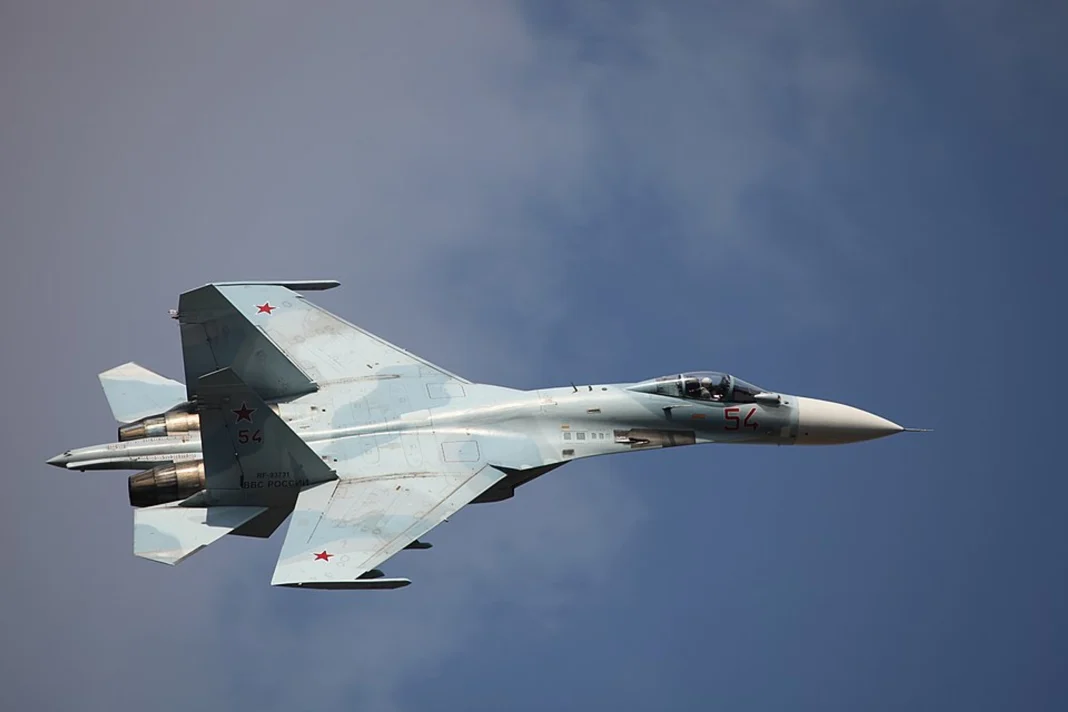Russian Su-27UB combat training aircraft was destroyed in an explosion at the Armavir airfield, located in Russia’s Krasnodar Krai.
Explosion at Airbase Destroys Russian Fighter Jet
This incident was confirmed by Ukraine’s Main Intelligence Directorate (HUR), which also released video footage showing the moment of destruction.
The Su-27UB was part of the Russian Aerospace Forces and was stationed at the airfield primarily used to train cadets of the Krasnodar Higher Military Aviation School of Pilots. Although the Su-27UB is mostly used for pilot training, it retains its full combat capability. This means that the aircraft can perform both practice missions and active military operations.
Shortly after the blast, residents in surrounding settlements reported a sudden loss of communication. While there is no official confirmation on the cause of the explosion from Russian authorities, the Ukrainian intelligence service hinted at growing acts of resistance within Russia. According to HUR, this attack is connected to actions being taken in response to the ongoing conflict.
No information has been shared about injuries, fatalities, or secondary damages caused by the blast. Officials in the region have not released public statements or media briefings on the condition of the airfield or whether flight operations were affected.
Ukraine’s Precision Strike Shatters Russia’s Elite $7M Drone Command Base in Kursk
Armavir Joins Growing List of Targeted Russian Airfields
This latest incident adds to a growing list of airfield attacks that have taken place across Russia in recent months. In June, the Kyiv Post reported that Ukraine’s intelligence services had launched long-range attacks against at least five military airfields in Russia. These airfields were located in the regions of Murmansk, Irkutsk, Ryazan, and Amur. The targeted sites were home to strategic bombers and surveillance aircraft.
According to Ukrainian reports, these were not isolated events but part of a larger, coordinated campaign aimed at weakening Russia’s aerial operations. The Security Service of Ukraine (SBU) has since confirmed that it was behind several of these strikes. One of the biggest of these efforts was a drone attack under the codename “Spiderweb.”
The SBU said that the Spiderweb operation was a long-term covert mission. Its main target was airfields that housed Russia’s cruise missile-capable aircraft. The strikes reportedly damaged or destroyed a significant portion of Russia’s long-range bombers. The Ukrainian side claims that about 34% of the strategic cruise missile carriers were hit during the strikes.
The total financial cost of damage from these drone attacks has been estimated by Ukrainian sources to be around $7 billion. However, this figure has not been confirmed by independent sources or by Russian authorities. There are also no public photographs or verified videos showing the extent of the damage at the other airfields mentioned.
🔐 Ukraine wipes Gazprom’s core systems in massive cyber blitz—servers destroyed, 390 branches hit
Military Pressure Continues Through Drone Warfare and Intelligence
The destruction of the Su-27UB jet at Armavir reflects an ongoing pattern of pressure on Russian air capabilities. Ukrainian officials and media have frequently reported that drone attacks and sabotage operations are now being used as strategic tools. These methods are believed to reach far beyond traditional battlefronts and aim at targets deep within Russian territory.
According to HUR, the destruction at Armavir was not a random act but part of this expanding set of operations. The Ukrainian intelligence service stated that it is acting in response to crimes committed against Ukrainian civilians and infrastructure.
In addition to drone strikes, there have been reports of other forms of sabotage, including attempts to disrupt transportation, communication, and military logistics in different regions of Russia. The use of covert tactics, such as long-range drones and remote explosives, allows operations to be carried out without requiring direct physical presence in the target zones.
Though the Su-27UB is technically a training aircraft, its combat capabilities make it an asset to Russia’s air fleet. Damaging or eliminating such equipment adds pressure on Russian military resources, particularly as trained pilots also require aircraft to complete their combat readiness cycles.
As part of these intelligence-based operations, the Ukrainian security forces appear to be increasingly targeting high-value assets that support or carry out long-range missions. The use of modern technology and intelligence coordination has allowed operations like “Spiderweb” to be carried out across several thousand kilometers.
Despite the growing number of attacks, independent access to the affected airfields remains highly restricted. Satellite imagery, drone footage, and official confirmations from the countries involved are the only available sources of information. Russian authorities have not publicly acknowledged most of the claimed damages.
🧨 Sanctions hit hard — Zelensky urges final blow as Russian economy spirals
The destruction at Armavir adds another data point in this trend, showing that rear bases and training centers are now within the reach of remote-strike capabilities. In the case of the Su-27UB, both its training and combat functions make its loss significant. Video released by Ukrainian intelligence confirms the aircraft’s destruction but does not show other surrounding equipment or infrastructure.

